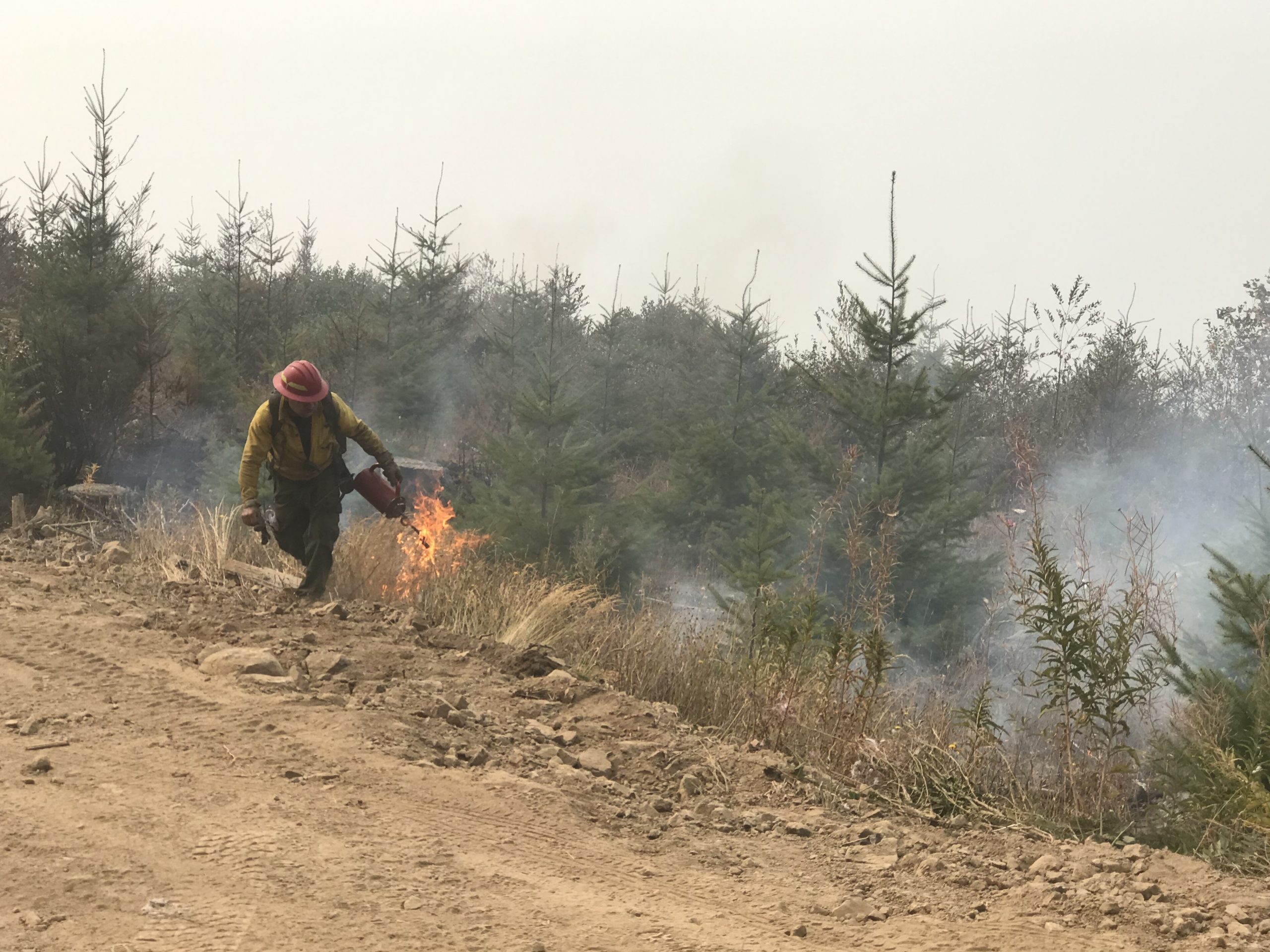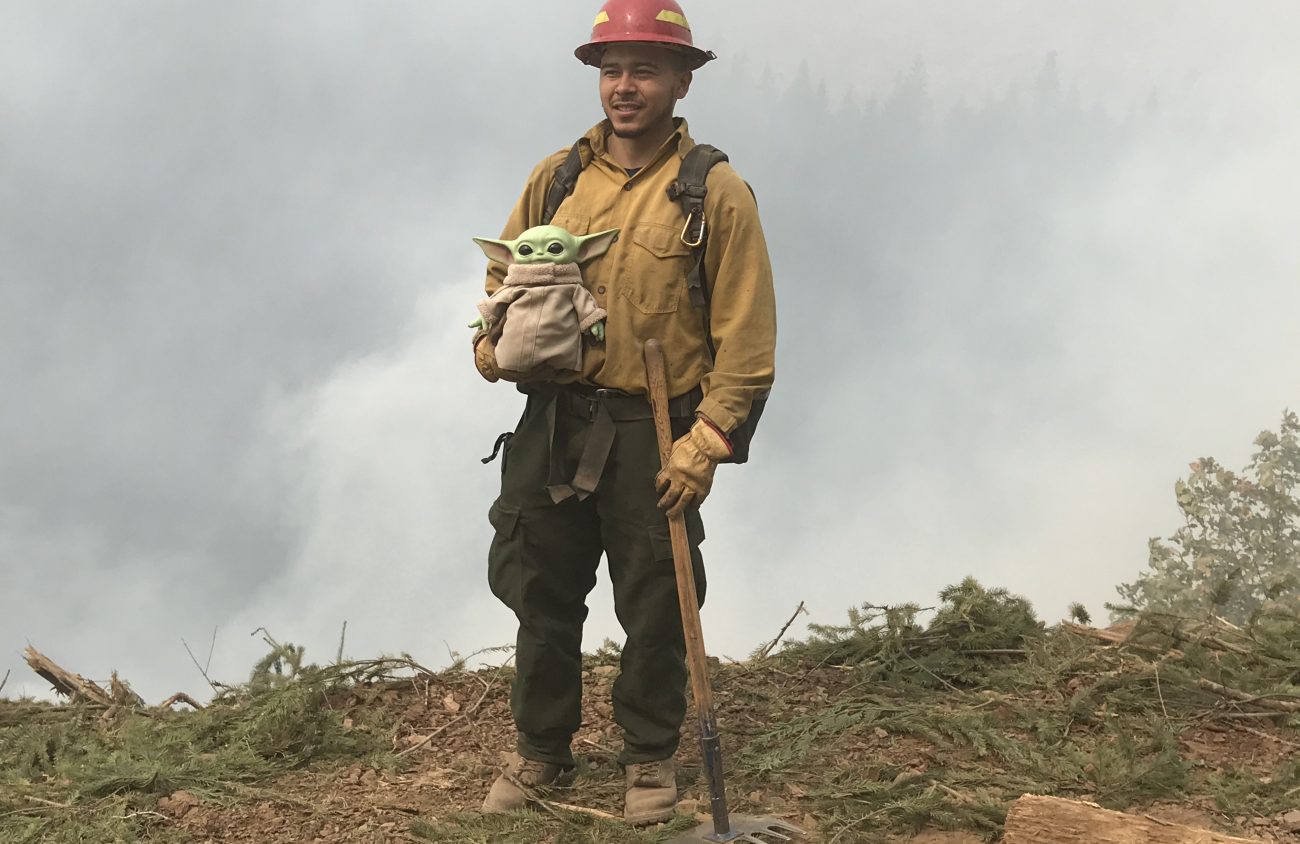When a Baby Yoda doll shows up to the Holiday Farm Fire, no wildland firefighter is too cool to pose with it.
Firefighters drop their tools to hold the recent Star Wars character from the TV show Mandalorian on Disney+.
Each firefighter holds The Force-sensitive creature for a moment, poses for a photo and passes it down to the next person — smiling the whole time as a controlled fire burns behind them, adding to a blanket of smoke in the sky. It’s a light moment for the firefighters who are working long shifts and fighting a fire that grew to more than 170,000 acres and destroyed communities and hundreds of structures.
The Baby Yoda has been making its way to different wildfires in Oregon ever since Carver, a 5-year-old boy from Scappoose, gave it to a firefighter. Before it showed up at Holiday Farm Fire, it was at Lionshead.
“Thank you firefighters, here’s a friend in case you get lonely,” says Oregon Department of Forestry press information officer Marcus Kauffman, reading a letter from Carver that travels with the Baby Yoda.
Kauffman, folding the letter back into Baby Yoda’s gown, then says Baby Yoda is a source of light in the world.
Thanks to a gift from a 5 year old, Baby Yoda is helping out at the Holiday Farm Fire. Baby Yoda was previously at the Lionshead Fire. pic.twitter.com/JVwySlP0uB
— Henry Houston (@hwhouston1) September 18, 2020
On Sept. 17, hours before rain pounded the Willamette Valley, Eugene Weekly visited a fire line on Weyerhaeuser property, one of many private forestlands hit hard by the Holiday Farm Fire.
The wildfire has left its mark on the private forestland, in addition to the communities farther east like Blue River. But firefighters are using the time before the rain and lightning to prevent the possibility of wildfire spreading. While firefighters take part in this stage, a new medic team from Roseburg has arrived to provide medical support if needed.
The city of Eugene SUV rocks up and down on a dusty road as we drive toward a fire line on Weyerhaeuser’s property. The charred scenery of the private forest is staggering. On a hillside, all is left is scorched earth and blackened tree stumps.
Weyerhaeuser’s forest near Leaburg and Walterville is basically burned up. According to Mason, Bruce and Girard, a Portland-based forestry and natural resources consulting firm, 92,600 acres owned by private large forest companies in Lane County have burned. That’s nearly 60 percent of acreage scorched from the Holiday Farm Fire.
President Donald Trump has criticized the West Coast states for its lack of forest management. But Oregon Wild’s Fire Policy blames hundreds of years of logging, grazing and fire suppression that has eliminated the fine fuels that are necessary for low-intensity fires. The long-range goal of forest management should be to restore through prescribed fire and not fire prevention, the policy adds.
About 20 firefighters stand armed with equipment like torches, rakes and axes. They’re keeping an eye downhill on the vegetation as a few men burn vegetation, resulting in a cloud of smoke rising into a sea of gray.

Chris Uniack is on the line and works with Grayback Forestry in White City. He says as that part of the fire line, firefighters are burning vegetation like young trees and bushes.
“Rather than let the fire push and hit our line hard, we’re taking the opportunity before the rain comes to burn some of the excess fuels,” he says. “That way we have a solid black edge.”
He says a wildfire could spread further on the property if they don’t burn the vegetation.
“It’ll build up more intensity and throw up more embers,” he adds. “When the main fire does come out of there, it’ll hit the area that we treated and it’ll slow down.”
A wildfire ember can travel more than a mile. So several firefighters occasionally climb up to a nearby green area behind the fire line to make sure fires don’t start there, Uniack says.
If someone on the line is hurt, a utility vehicle with medics from Roseburg is on its way to help. Travis Doggett of the Rapid Extrication Module Support (REMS) team says a lot of injuries happen at the clean up stage of the fire fighting. He says his four-member team includes two medics.
“We’re there to get people off the line and to definitive care, that being a hospital,” he says.
Doggett says the REM team responds to injuries that range from a bee sting to a tree falling on a firefighter, as well as symptoms like chest pains and shortness of breath.
“They get tired and mistakes happen,” he says.
The REMS team has a four-seat utility vehicle that can handle the rugged terrain of a fire line. The UTV has rope bags, carabiners and other equipment that help the team secure an injured firefighter and pull them to the vehicle, he says. On the UTV’s bed, there’s a chair for a medic to sit in while the injured firefighter lays on a gurney.
“At that point, we can package them up and transport them with a caregiver in the back to provide aid,” he says.
On Sept. 18, Holiday Farm Fire communications team reports that a tree faller was injured by a falling limb and was taken to the hospital with non-life threatening injuries.
Wildland firefighting is filled with life-threatening injuries from smoke-inhalation injuries to burnovers and entrapment. According to the Centers for Disease Control and the National Institute for Occupational Safety and Health, more than 400 wildland firefighters have died on the job from 2000 to 2019. And in 2019, there were nine fatalities and 73 injuries, according to the Wildland Fire Lessons Learned Center.
So hopefully for Oregon’s wildland firefighters, Carver’s Baby Yoda protects them with The Force.
